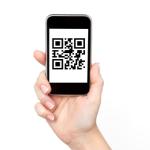Creating Custom QR Code Labels: What to Consider
This entry was posted on June 06, 2023 .

Leveraging the exciting technology behind QR code labels opens doors for brands of all industries and sizes to better communicate with their customers. The opportunity to allow your consumers to further interact with your products can help you to build brand loyalty and recognition, increasing sales over time. Learn how to create the most effective QR code labels for your products.
What Are QR Labels?
QR labels are a variation of barcode labels that allow customers to easily scan your product label and further interact with you online. A QR code has a square-shaped border that contains a unique pattern of squares, generally in black ink. With the capability to store more information than typical barcode labels and the ability to support alphanumeric characters, QR codes can quickly link your consumers to a URL. These labels can be scanned by smartphone cameras to instantly bring your customers to your desired link or material.
QR code labels are often used to drive customers to online materials such as:
- Recipes
- Instructions
- Engaging multimedia like games or videos
- Newsletter sign-up pages
- Product registration portals
- Articles about your product’s ingredients, your company history, or your mission
- Certifications and regulation compliance information
Whether your product and its label are too small to fit all of the information you’d like your customers to know or you’re working on an initiative to drive more newsletter signups, QR codes can quickly take your product labeling to the next level.
Dynamic vs. Static QR Codes
The first element to consider as you create QR code labels is whether you will utilize dynamic or static QR codes. Static QR codes contain fixed information that cannot be changed once the label has been printed. On the other hand, dynamic QR codes allow creators to change the information within the code without needing to order label reprints.
Each of these QR types has its own ideal use cases. Static QR codes make the most sense for showing a license or certification, listing your address or phone number, or detailing ingredients for a core product. On the other hand, if you’re creating a large batch of QR code labels and are still experimenting with a recipe or marketing tactic, dynamic QR codes will likely work best. Overall, dynamic QR codes give you more space to pivot and edit the material your customers will see, even after all of your labels are printed.
QR Code Label Design Tips
Creating an effective QR code label requires more than simply printing a QR code onto a BOPP label and calling it a day. In order to drive traffic to your desired URL through your QR code, follow a few simple design tips.
Add A Logo
As you design your QR code label, be sure to include an easily identifiable logo for your brand. Additionally, feature this same logo prominently on the website your QR leads to. This cohesive experience will help build brand awareness and recognition while assuring your users that the QR code is working correctly.
Make It Distinctive
In addition to including your logo, incorporate your signature brand colors and fonts into your label itself as well as your QR code’s destination. Making your materials distinctive will help you stand out from the rest of the products on the shelves.
Select Size Strategically
Designing QR code labels calls for a balance between subtlety and ease of use. While you don’t want your QR code to completely overtake the rest of your label design, you also don’t want it to be so tiny that it doesn’t scan reliably. Likewise, it’s important to select a size that is noticeable so that your consumers actually use it!
Include a CTA
While many customers may know automatically that if there’s a QR code, they can scan it for additional information, others may need a reminder of this technology. Whether you opt for a simple “Scan Me!” with an arrow pointing to your code or a compelling teaser for the content linked to your QR code, include a CTA that will help clarify the code’s purpose and drive your customers to interact with it as intended. Possible CTAs include:
- Scan for a discount!
- Scan for a delicious recipe!
- Scan to discover the secret to our sauce!
- Scan to start the scavenger hunt!
Your CTA should match your brand voice and give users an idea of what they’ll see when they scan your code.
Customize Your QR Code
If design and aesthetics are particularly important to your brand, you may consider customizing your QR code for your label design. Choosing unique shapes and patterns may help the code stand out and intrigue consumers to try out your product and check out your link.
Run Tests
Before your QR code label design is finalized, take the time to run tests to ensure that the code works as expected. The last thing you want is to print a batch of QR code labels that won’t lead to your intended URL.
With Lightning Labels, you can rest assured that our printing process will create crisp, functional QR codes regardless of your chosen material type. From glossy to transparent to paper-based labels, each of our materials supports this exciting labeling technology. Utilize QR code labels for your next product to increase customer engagement and provide a more in-depth experience for your consumers. Get an instant online quote today.

 Custom Labels
Custom Labels  Custom Beverage Labels
Custom Beverage Labels  Custom Lip Balm Labels
Custom Lip Balm Labels  Custom Warning & Safety Labels
Custom Warning & Safety Labels  Perfume Bottle Labels
Perfume Bottle Labels  Bumper Stickers
Bumper Stickers  Custom Prop 65 Warning Labels
Custom Prop 65 Warning Labels  Custom Stickers
Custom Stickers